Access Control and Pilot Allocation for Machine-Type Communications in Crowded Massive MIMO Systems
Abstract
1. Introduction
2. System Model and Preliminaries
2.1. System Model
2.2. Access Class Barring Scheme
2.3. SUCRe Protocol
- Step 1
- Select Random Pilot Sequence: Each MTCD randomly selects a pilot from the set of pilots in each RA slot with equal probability , and then this pilot is sent to the BS.
- Step 2
- Generate and Broadcast Precoded Random Access Response (PRAR), ACB Factor and the Information of Idle Pilots: After the BS receives the pilot signal, it generates the PRAR and broadcast this PRAR to all active MTCDs.
- Step 3
- Contention Resolution using Pilot Repetition and Pilot Reselection: Each active MTCDs receives the PRAR information and checks whether it has the strongest uplink signal gain, which can be accomplished by comparing its own channel gain and an estimate of the sum of the channel gains of the other contending MTCDs. Only the strongest MTCD should repeat the RA pilot.
- Step 4
- The BS Allocates Dedicated Payload Pilots: The repeated RA pilots are transmitted by MTCDs to the BS during step 3. Then, the BS checks whether an MTCD suffers from pilot collision or not based on the repeated RA pilot signals. The BS allocates the dedicate data pilots to MTCDS who do not suffers from collision.
3. Dynamic Access Control and Pilot Allocation Algorithm
3.1. Optimization Problem and Algorithm
3.1.1. Estimation Phase
3.1.2. Access Control Phase
| Algorithm 1 Dynamic Access Control and Pilot Allocation Algorithm |
4. Simulation Results
- SUCRe: This method was proposed in [12]. It can resolve pilot collisions when devices select pilot sequence at random to access the network. Each device with the strongest channel gain will be assigned one pilot.
- RA w/o ACB: This is a traditional random access procedure without controlling the number of arrival devices. In an access attempt, if more than one device selects the same pilot sequence, they will fail to access the network.
- SUCRe with fixed ACB: We use a fixed ACB factor () to limit the number of arrival devices and apply the SUCRe protocol for pilot allocation.
- RA with fixed ACB: Similar to SUCRe with fixed ACB, an access control using a fixed ACB factor () is applied.
- SUCRe with traffic-aware ACB: access control is realized based on traffic-aware ACB factor before the SUCRe protocol will make pilot allocation.
- RA with traffic-aware ACB: random access procedure based on controlling the number of new arrivals by traffic-aware ACB scheme.
5. Conclusions
Author Contributions
Funding
Conflicts of Interest
References
- Tomtsis, D.; Kokkonis, G.; Kontogiannis, S. Evaluating existing wireless technologies for IoT data transferring. In Proceedings of the 2017 South Eastern European Design Automation, Computer Engineering, Computer Networks and Social Media Conference, Kastoria, Greece, 23–25 September 2017; pp. 1–4. [Google Scholar] [CrossRef]
- Alreshidi, A.; Ahmad, A. Architecting Software for the Internet of Thing Based Systems. Future Internet 2019, 11, 153. [Google Scholar] [CrossRef]
- Payne, E.K.; Lu, S.W.Q.W.L. Concept of Designing Thermal Condition Monitoring System with ZigBee/GSM Communication Link for Distributed Energy Resources Network in Rural and Remote Applications. Processes 2019, 7, 383. [Google Scholar] [CrossRef]
- Persia, S.; Rea, L. Next generation M2M Cellular Networks: LTE-MTC and NB-IoT capacity analysis for Smart Grids applications. In Proceedings of the 2016 AEIT International Annual Conference (AEIT), Capri, Italy, 5–7 October 2016; pp. 1–6. [Google Scholar] [CrossRef]
- Bjornson, E.; Larsson, E.G.; Debbah, M. Massive MIMO for Maximal Spectral Efficiency: How Many Users and Pilots Should Be Allocated? IEEE Trans. Wirel. Commun. 2016, 15, 1293–1308. [Google Scholar] [CrossRef]
- Saraereh, O.A.; Khan, I.; Alsafasfeh, Q.; Alemaishat, S.; Kim, S. Low-Complexity Channel Estimation in 5G Massive MIMO-OFDM Systems. Symmetry 2019, 11, 713. [Google Scholar] [CrossRef]
- Bjornson, E.; Larsson, E.G.; Marzetta, T.L. Massive MIMO: Ten myths and one critical question. IEEE Commun. Mag. 2016, 54, 114–123. [Google Scholar] [CrossRef]
- Vieira, J.; Malkowsky, S.; Nieman, K.; Miers, Z.; Kundargi, N.; Liu, L.; Wong, I.; Öwall, V.; Edfors, O.; Tufvesson, F. A flexible 100-antenna testbed for Massive MIMO. In Proceedings of the 2014 IEEE Globecom Workshops (GC Wkshps), Austin, TX, USA, 8–12 December 2014; pp. 287–293. [Google Scholar] [CrossRef]
- Rusek, F.; Persson, D.; Lau, B.K.; Larsson, E.G.; Marzetta, T.L.; Edfors, O.; Tufvesson, F. Scaling Up MIMO: Opportunities and Challenges with Very Large Arrays. IEEE Signal Process. Mag. 2013, 30, 40–60. [Google Scholar] [CrossRef]
- Sanguinetti, L.; D’Amico, A.A.; Morelli, M.; Debbah, M. Random Access in Uplink Massive MIMO Systems: How to Exploit Asynchronicity and Excess Antennas. In Proceedings of the 2016 IEEE Global Communications Conference (GLOBECOM), Washington, DC, USA, 4–8 December 2016; pp. 1–5. [Google Scholar] [CrossRef]
- Sorensen, J.H.; de Carvalho, E.; Popovski, P. Massive MIMO for crowd scenarios: A solution based on random access. In Proceedings of the 2014 IEEE Globecom Workshops, Austin, TX, USA, 8–12 December 2014; pp. 352–357. [Google Scholar] [CrossRef]
- Bjornson, E.; de Carvalho, E.; Larsson, E.G.; Popovski, P. Random access protocol for massive MIMO: Strongest-user collision resolution (SUCR). In Proceedings of the 2016 IEEE International Conference on Communications, Kuala Lumpur, Malaysia, 22–27 May 2016; pp. 1–6. [Google Scholar] [CrossRef]
- Study on RAN Improvements for Machine-Type Communications. 3GPP TR 37.868 V11.0.0. September 2011. Available online: https://portal.3gpp.org/desktopmodules/Specifications/SpecificationDetails.aspx?specificationId=2630 (accessed on 20 June 2019).
- Lien, S.; Chen, K.; Lin, Y. Toward ubiquitous massive accesses in 3GPP machine-to-machine communications. IEEE Commun. Mag. 2011, 49, 66–74. [Google Scholar] [CrossRef]
- Ksentini, A.; Hadjadj-Aoul, Y.; Taleb, T. Cellular-based machine-to-machine: Overload control. IEEE Netw. 2012, 26, 54–60. [Google Scholar] [CrossRef]
- Duan, S.; Shah-Mansouri, V.; Wang, Z.; Wong, V.W.S. D-ACB: Adaptive Congestion Control Algorithm for Bursty M2M Traffic in LTE Networks. IEEE Trans. Veh. Technol. 2016, 65, 9847–9861. [Google Scholar] [CrossRef]
- Zheng, K.; Ou, S.; Alonso-Zarate, J.; Dohler, M.; Liu, F.; Zhu, H. Challenges of massive access in highly dense LTE-advanced networks with machine-to-machine communications. IEEE Wirel. Commun. 2014, 21, 12–18. [Google Scholar] [CrossRef]
- Ali, M.S.; Hossain, E.; Kim, D.I. LTE/LTE-A Random Access for Massive Machine-Type Communications in Smart Cities. IEEE Commun. Mag. 2017, 55, 76–83. [Google Scholar] [CrossRef]
- Access Class Barring and Overload Protection. 3GPP TR23.898 V7.0.0. March 2005. Available online: https://portal.3gpp.org/desktopmodules/Specifications/SpecificationDetails.aspx?specificationId=977 (accessed on 22 April 2019).
- He, H.; Du, Q.; Song, H.; Li, W.; Wang, Y.; Ren, P. Traffic-aware ACB scheme for massive access in machine-to-machine networks. In Proceedings of the 2015 IEEE International Conference on Communications, London, UK, 8–12 June 2015; pp. 617–622. [Google Scholar] [CrossRef]
- Kapsalis, V.; Hadellis, L.; Karelis, D.; Koubias, S. A dynamic context-aware access control architecture for e-services. Comput. Secur. 2006, 25, 507–521. [Google Scholar] [CrossRef]
- Colombo, P.; Ferrari, E. Enhancing NoSQL datastores with fine-grained context-aware access control: A preliminary study on MongoDB. Int. J. Cloud Comput. 2017, 6, 292–305. [Google Scholar] [CrossRef]
- Kim, Y.G.; Mon, C.J.; Jeong, D.; Lee, J.O.; Song, C.Y.; Baik, D.K. Context-Aware Access Control Mechanism for Ubiquitous Applications. In Advances in Web Intelligence; Szczepaniak, P.S., Kacprzyk, J., Niewiadomski, A., Eds.; Springer: Berlin/Heidelberg, Germany, 2005; pp. 236–242. [Google Scholar]
- Kayes, A.S.M.; Rahayu, W.; Dillon, T.; Chang, E. Accessing Data from Multiple Sources Through Context-Aware Access Control. In Proceedings of the 2018 17th IEEE International Conference on Trust, Security and Privacy in Computing and Communications/12th IEEE International Conference on Big Data Science and Engineering (TrustCom/BigDataSE), New York, NY, USA, 1–3 August 2018; pp. 551–559. [Google Scholar] [CrossRef]
- Bjornson, E.; de Carvalho, E.; Sørensen, J.H.; Larsson, E.G.; Popovski, P. A Random Access Protocol for Pilot Allocation in Crowded Massive MIMO Systems. IEEE Trans. Wirel. Commun. 2017, 16, 2220–2234. [Google Scholar] [CrossRef]
- Phuyal, U.; Koc, A.T.; Fong, M.H.; Vannithamby, R. Controlling access overload and signaling congestion in M2M networks. In Proceedings of the 2012 Conference Record of the Forty Sixth Asilomar Conference on Signals, Systems and Computers, Pacific Grove, CA, USA, 4–7 November 2012; pp. 591–595. [Google Scholar] [CrossRef]
- Ngo, H.Q.; Larsson, E.G.; Marzetta, T.L. Aspects of favorable propagation in massive MIMO. In Proceedings of the 2014 Proceedings of the 22nd European Signal Processing Conference (EUSIPCO), Lisbon, Portugal, 1–5 September 2014; pp. 76–80. [Google Scholar]
- Oh, C.; Hwang, D.; Lee, T. Joint Access Control and Resource Allocation for Concurrent and Massive Access of M2M Devices. IEEE Trans. Wirel. Commun. 2015, 14, 4182–4192. [Google Scholar] [CrossRef]
- Spatial Channel Model for Multiple Input Multiple Output (MIMO). 3GPP TR 25.996 V13.0.0. December 2015. Available online: https://portal.3gpp.org/desktopmodules/Specifications/SpecificationDetails.aspx?specificationId=1382 (accessed on 7 May 2019).
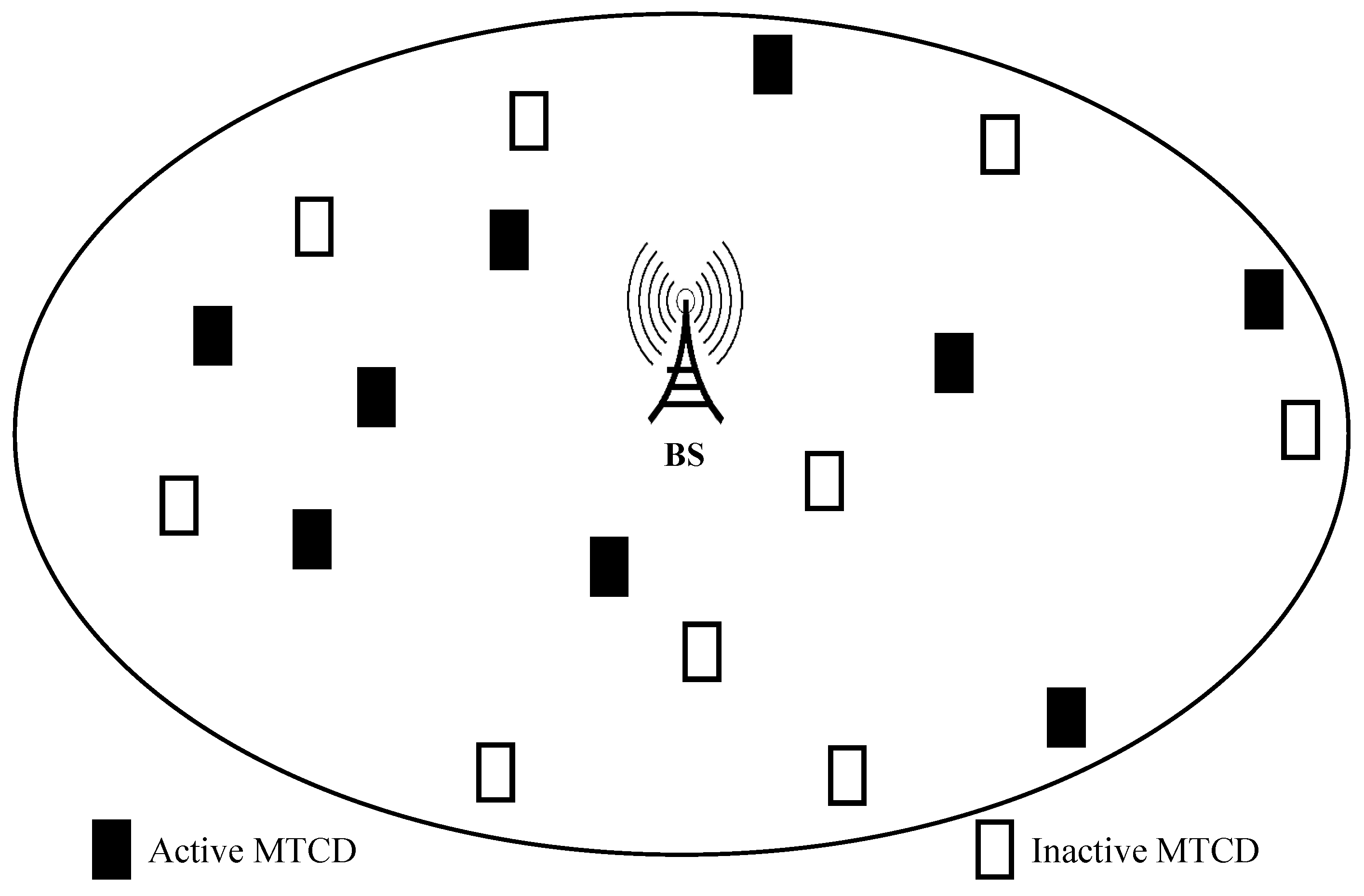
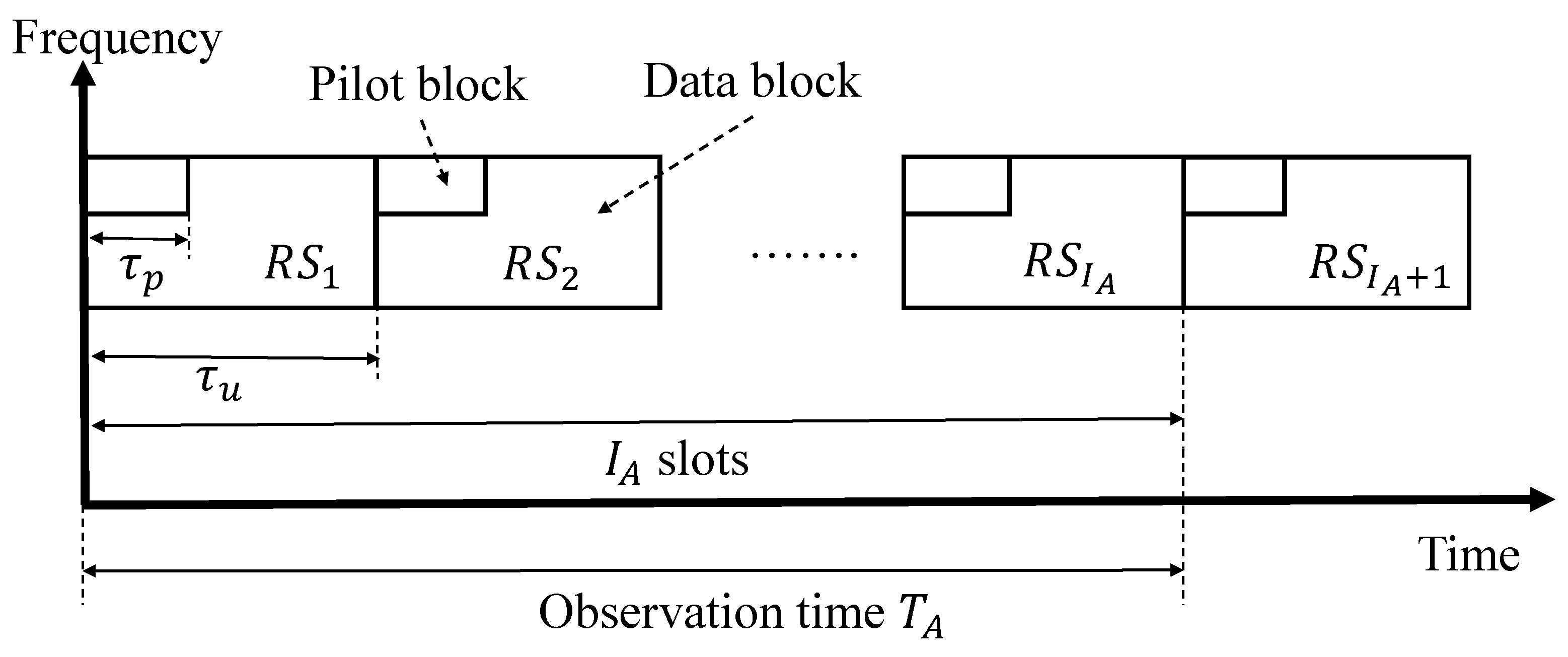
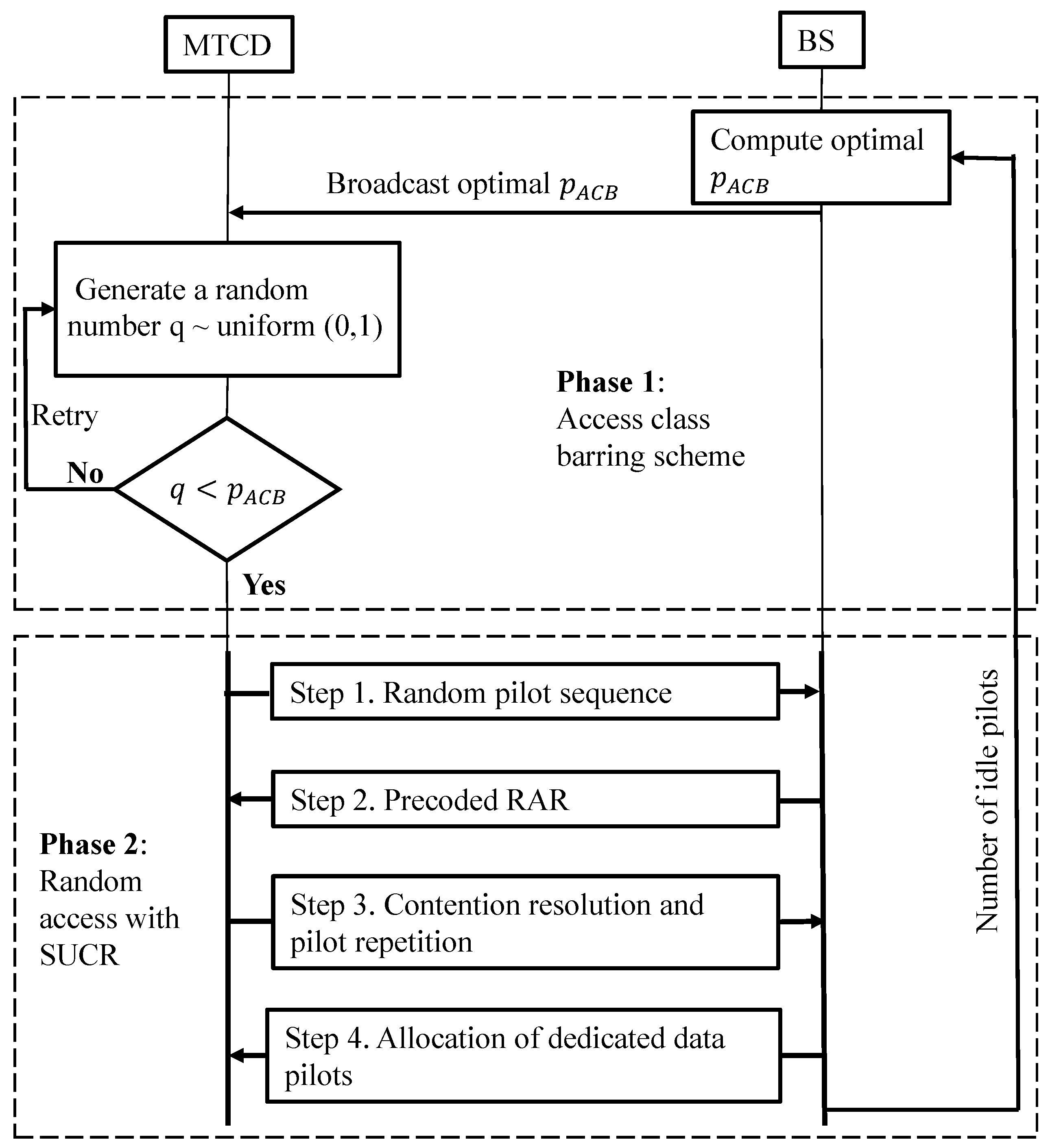
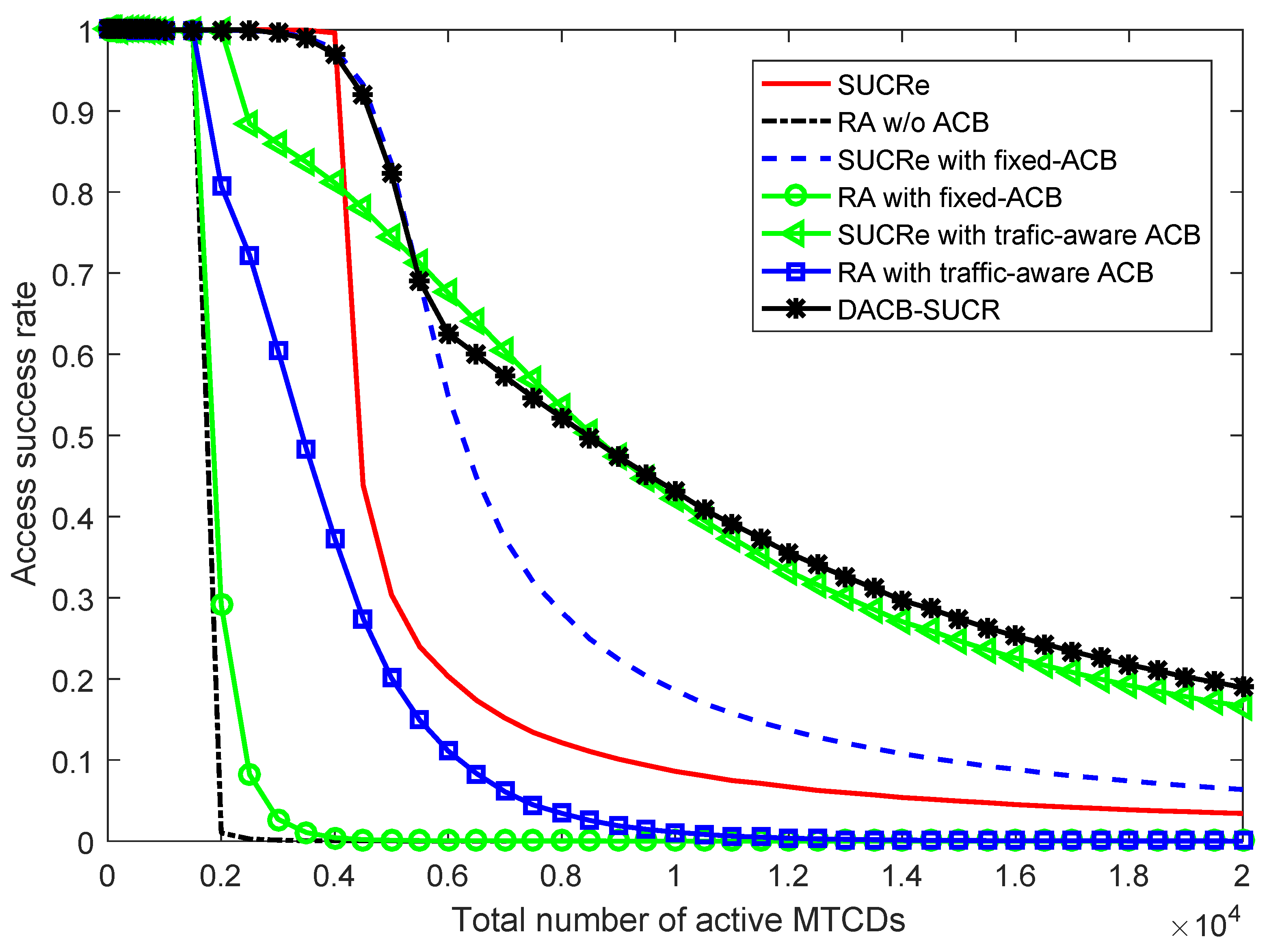
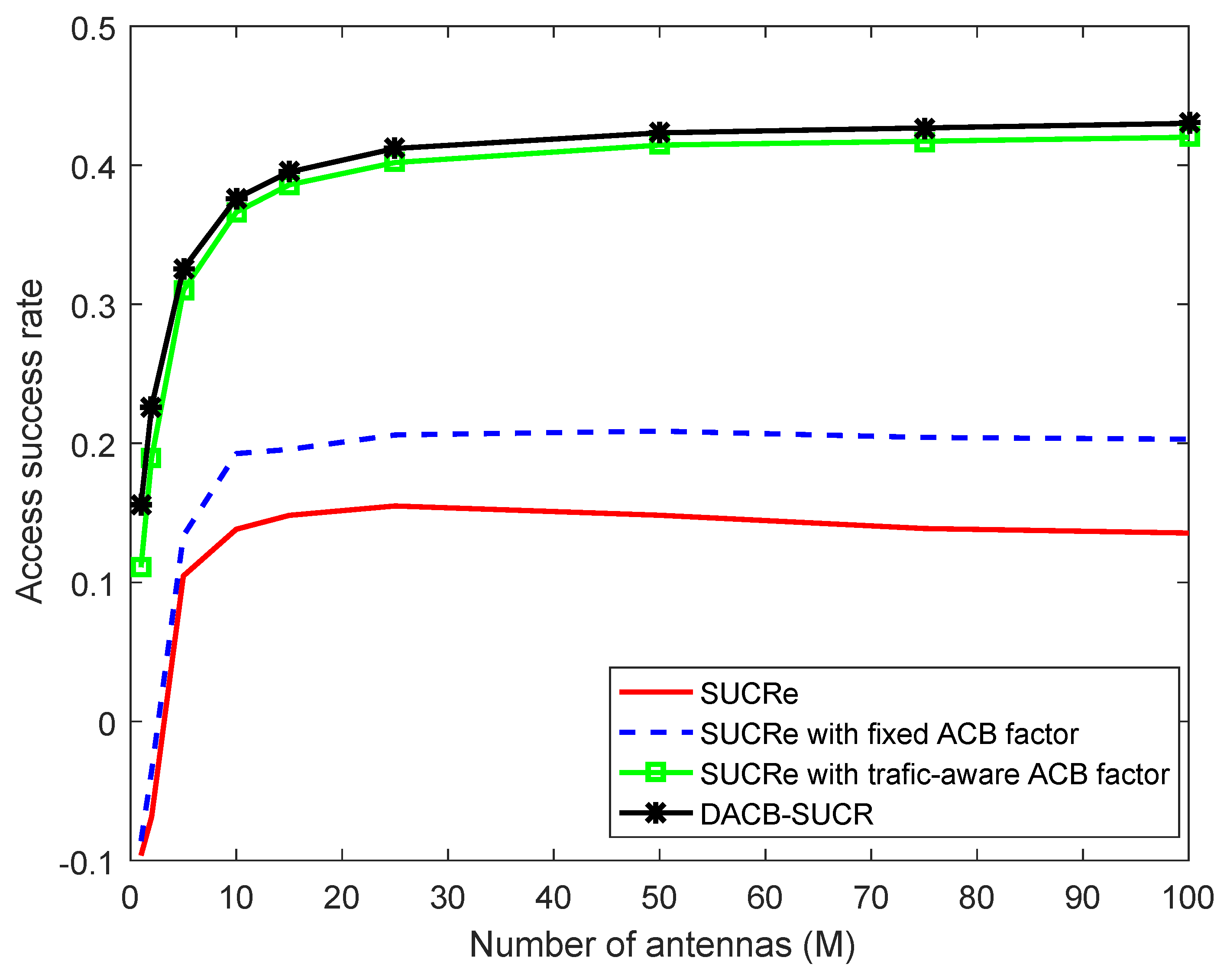
| Method | Success Access Rate (%) | |
|---|---|---|
| SUCRe | 10.13 | 14.93 |
| SUCRe with fixed ACB factor | 13.35 | 20.27 |
| SUCRe with traffic-aware ACB factor | 30.67 | 42.07 |
| DACB-SUCR | 32.49 | 43.03 |
© 2019 by the authors. Licensee MDPI, Basel, Switzerland. This article is an open access article distributed under the terms and conditions of the Creative Commons Attribution (CC BY) license (http://creativecommons.org/licenses/by/4.0/).
Share and Cite
Vo, T.-H.; Ding, Z.; Pham, Q.-V.; Hwang, W.-J. Access Control and Pilot Allocation for Machine-Type Communications in Crowded Massive MIMO Systems. Symmetry 2019, 11, 1272. https://doi.org/10.3390/sym11101272
Vo T-H, Ding Z, Pham Q-V, Hwang W-J. Access Control and Pilot Allocation for Machine-Type Communications in Crowded Massive MIMO Systems. Symmetry. 2019; 11(10):1272. https://doi.org/10.3390/sym11101272
Chicago/Turabian StyleVo, Ta-Hoang, Zhi Ding, Quoc-Viet Pham, and Won-Joo Hwang. 2019. "Access Control and Pilot Allocation for Machine-Type Communications in Crowded Massive MIMO Systems" Symmetry 11, no. 10: 1272. https://doi.org/10.3390/sym11101272
APA StyleVo, T.-H., Ding, Z., Pham, Q.-V., & Hwang, W.-J. (2019). Access Control and Pilot Allocation for Machine-Type Communications in Crowded Massive MIMO Systems. Symmetry, 11(10), 1272. https://doi.org/10.3390/sym11101272





